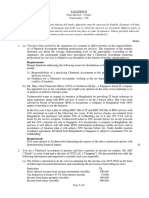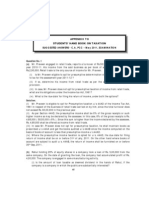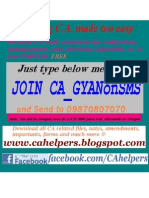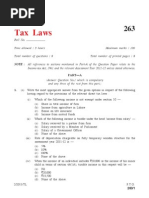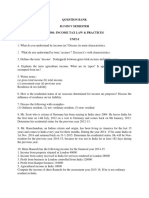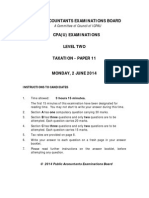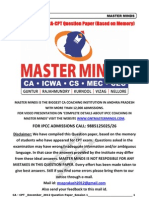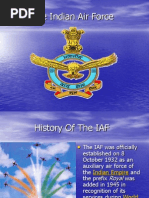CA IPCC Exam
CA IPCC Exam
Uploaded by
Tushar BhattacharyyaCopyright:
Available Formats
CA IPCC Exam
CA IPCC Exam
Uploaded by
Tushar BhattacharyyaOriginal Description:
Copyright
Available Formats
Share this document
Did you find this document useful?
Is this content inappropriate?
Copyright:
Available Formats
CA IPCC Exam
CA IPCC Exam
Uploaded by
Tushar BhattacharyyaCopyright:
Available Formats
MOCK TEST Category-C Full Syllabus
IPCC A.Y.2013-14
Total No. of Question 7] Time Allowed 3 Hours [Total No. of Printed Pages 9 Maximum Marks 100 Answers to questions are to be given only in English except in the case of candidates who have opted for Hindi medium. If a candidate who has not opted for Hindi medium, answers in Hindi, his answers in Hindi will not be valued. Question No.1 is compulsory Attempt any five questions from the remaining six questions. Wherever required, suitable assumptions may be made by the candidate. Working notes should form part of the answer.
1(a).
Mrs. Purvi is a Chartered Accountant in practice. She maintains her accounts on cash basis. Her income and Expenditure account for the year ended March 31, 2013 reads as follows: Expenditure Salary to Staff Stipend to articled Assistants Incentive to Articled Assistants Office rent Printing and Stationery Meeting, Seminar and Conference Purchase of car ` Income ` `
Marks 10
5,50,000 Fees earned: Audit 7,88,000 37,000 Taxation Services 5,40,300 3,000 24,000 Consultancy 2,70,000 15,98,300 22,000 Dividend on shares of 10,524 Indian Companies(Gross) 31,600 Income from unit Trust 7,600 of India 80,000 Honorarium received from Various Institutions for valuation 15,800 of answer papers 4,000 Rent Received from Residential flat let out 35,000 3,000 9,28,224 17,17,824 85,600
Repair, Maintenance And petrol of car Travelling expenses Municipal Tax paid in respect of house Property Net profit
17,17,824
2 Other information: (i) (ii) Allowable rate of depreciation on motor car is 15% Value of benefits received from clients during the course of profession is `10,500. Incentives to articled assistants represent amount paid to two articled assistants for the passing IPCC Examination at first attempt. Repairs and maintenances of car include ` 2,000 for the period from 01.10.2012 to 30.09.2013. Salary include `30,000 to a computer specialist in cash for assisting Mrs. Purvi in one professional assignment. The total travelling expenses incurred on foreign tour was `32,000 which was within the RBI norms. Medical Insurance premium on the health of dependent brother and major son dependent on her amounts to `5,000 and `10,000 respectively paid in cash. She invested an amount of `10,000 in National Saving Certificate.
(iii)
(iv)
(v)
(vi)
(vii)
(viii)
Compute the Total Income and Tax Payable of Mrs. Purvi for the Assessment Year 2013-2014. 1(b). Rishabh Professionals Ltd. is engaged in providing services which became taxable with effect from July 01, 2012. Compute the service tax payable by Rishabh Professionals Ltd. on the following amounts (exclusive of service tax) received for the month of March, 2013:Particulars Services performed during March 2013 Services by way of renting of residential dwelling for use as residence Market Value of free services rendered to the friends Advance received in March,2013 for services to be rendered in July, 2013 (The agreement got terminated in April, 2013. Hence, no services were rendered in July,2013. However, a sum of ` 3,50,000 was refunded in June, 2013) Other receipts Amount (`) 5,00,000 1,50,000 20,000 5,00,000 Marks 4
12,00,000
3 1(c). Compute net VAT liability of Rishi from the following information: Particulars Raw materials from foreign market (Including Import duty @ 20% plus EC) Raw material purchased from local market Cost of raw material Add: Excise duty @ 16% Add: VAT @ 4% Raw material purchased from (Including CST @ 2%) Storage and transportation cost Manufacturing expenses neighbouring State ` ` 1,23,600 Marks 4
2,50,000 40,000 2,90,000 11,600
3,01,600 51,000 9,000 30,000
Rishi sold goods to Madan and earned profit @ 12% on the cost of production. VAT rate on sale of such goods is 4%. 1(d). Briefly explain the Exemption available to small scale service providers in reference to service tax. Marks 2
2(a).
Mr. X is a Dealer Registered in Delhi Value Added Tax Act, 2004 and also under Central Sales Tax Act, 1956 and he has submitted the informations as given below: (i) Purchased Goods A from Delhi `1,00,000 inclusive of VAT @ 4% and sold the goods in Delhi for `1,50,000 inclusive of VAT @ 4%. (ii) Purchased goods B from U.P. for `2,00,000 inclusive of central sales tax @ 2% and sold goods in Delhi for `2,50,000 inclusive of VAT @ 12.5%. (iii) Purchased goods C from Delhi for `4,00,000 inclusive of VAT @ 12.5% and sold the goods to a registered dealer in Orissa for `4,75,000 inclusive of central sales tax @ 2% (iv) Purchased goods D for `5,00,000 in Delhi inclusive of VAT @ 12.5% and sold the goods for `5,50,000 to an unregistered dealer in Punjab inclusive of central sales tax @ 12.5%. (v) Purchased goods E from Madhya Pradesh for `3,00,000 inclusive of central sales tax @ 1% and sold goods in Maharashtra for `3,50,000 inclusive of central sales tax @ 1%. (vi) Purchased goods F from Delhi `7,00,000 inclusive of VAT @ 1% and the goods were sold to an unregistered dealer in Maharashtra for `7,50,000 inclusive of central sales tax @ 1%. (vii) Purchased goods G for `6,00,000 in Delhi inclusive of VAT @ 12.5% and goods were stock transferred to some other state. (viii) Purchased goods H for `8,00,000 in Delhi inclusive of VAT @ 4% and goods were exported for `8,50,000 and no VAT was charged (because as per section 6 Central
Marks 8
4 Sales Tax Act, 1956, CST cannot be charged in case of export sale.) (ix) Purchased goods I for `9,00,000 in Delhi inclusive of VAT @ 12.5% and sold the goods to a manufacturer in SEZ for `10,50,000 and no VAT was charged. Show the tax treatment for VAT and also compute his income tax liability for the assessment year 2013-14. 2(b). Compute capital gains in the following situations for the assessment year 2013-14: Asset Date of purchase Cost price Cost of improvement Year of improvement Fair market value 01.04.1981 Gold 01.07.1978 3,00,000 20,000 1979-80 on 2,90,000 01.01.2013 30,00,000 Land 01.04.1980 5,00,000 1,00,000 1980-81 5,50,000 01.01.2013 32,00,000 Residential house 01.07.2010 7,00,000 3,00,000 2010-11 N.A. 01.01.2013 15,00,000 Personal Motor Car 01.05.2003 2,00,000 Nil 2006-07 N.A. 01.01.2013 1,80,000 Marks 4
Date of Sale Full value of consideration
2(c).
State with reasons, whether tax deduction at source provisions are applicable to the following transactions and if so, the rate of tax deduction: (i) X & Co. (Firm) engaged in wholesale business assigned a contract for construction of its godown building to Mr. Ravi, a contractor. It paid `25,00,000 to Mr. Ravi as contract payment. (ii) Y & Co. engaged in real estate business conducted a lucky dip and gave Maruti car to a prize winner. (iii) An Insurance Company paid `45,000 as Insurance Commission to its agent Mr. Hari. (iv) AB Ltd. allowed a discount of `50,000 to XY & Co. (a firm) on prompt (immediate) payment towards supply of automobile parts.
Marks 4
3(a).
Mr. Nixon, an American citizen, is appointed by a multi-national company to its branch in New Delhi in 2009. Mr. Nixon has never been to India before this appointment. He arrives in Bombay on 15 th April, 2009 and joins the New Delhi office on 20th April, 2009. His wife and children join him in India on 20 th October, 2009. The company allotted him a leased residence for purposes of his stay. This residence is occupied by him from the beginning of October, 2009. On 10th February, 2010, he is transferred by his employer, on deputation basis, to be the Regional Chief of his employers operations in South East Asia having headquarters in Hongkong. He leaves New Delhi on 11th February and arrives in Hongkong on 12th February, 2010. Mr. Nixon leaves behind his wife and children in India till 14th August, 2011, when they leave along with him for Hongkong. Mr. Nixon had come to India earlier on 15th June, 2011, on two months leave. The members of
Marks 6
5 the family occupied the residence till date of departure to Hongkong. At the end of the period of deputation, Mr. Nixon is reposted to India and joins the New Delhi office of his employer as Chief of Indian operations on 2nd February, 2013. In what residential status Mr. Nixon will be assessable, for the various years, to income tax in India?
3(b).
(i) Write a note on administration of service tax. (ii) List the documents to be submitted alongwith the first service tax return.
Marks 3+3
3(c).
Mr. Tony has estates in Rubber, Tea and Coffee. He derives income from them. He has also a nursery wherein he grows plants and sells. For the previous year ending 31.03.2013, he furnishes the following particulars of his sources of income from estates and sale of Plants. You are requested to compute the taxable income and tax liability for the assessment year 2013-14. ` (i) Manufacture of rubber (ii) Manufacture of coffee grown and cured (iii) Manufacture of tea (iv) Sale of plants from nursery 5,00,000 3,50,000 7,00,000 1,00,000
Marks 4
4(a).
Mr. X has submitted information given below. i) ii) iii) Income from owning and maintaining of race horse ` 2,00,000. Income from owning and maintaining of race camels ` 1,00,000. He had winning of ` 1,60,000 from horse race on 01.12.2012 and winning from camel race `1,80,000 on 07.12.2012. He purchased lottery tickets of `10,000 on 01.02.2013 and had winning of `2,00,000 on 12.02.2013. He has received Royalty of book of literary nature @ 50% of print price of ` 600 and total copies sold are 2,000 He has paid advance tax as given below: Upto 15.09.2012 ` 30,000 Upto 15.12.2012 ` 80,000 Upto 15.03.2013 ` 1,30,000
Marks 5
iv)
v)
vi)
Balance was paid on 10.06.2013 Compute tax liability for the A.Y 2013-14 and interest under section 234A, 234B and 234C.
6 4(b). Write a note on Signing of Return of Income of all the assessee. Marks 3 Marks 2+2
4(c).
(i) How will a taxable service be valued when the consideration thereof is not wholly or partly in terms of money? (ii) Write a note in brief on Provisional Payment of Service Tax.
4(d).
(i) Under what circumstances registration can be cancelled under VAT? (ii) Briefly explain the income variant of VAT.
Marks 2+2
5(a).
(i)
Nathan Aviation Ltd. is running two industrial undertakings, one in a SEZ (Unit S) and another in a normal area (Unit N). The brief summarized details for the year ended 31.03.2013 are as under: (` in lacs) S N Domestic turnover Export turnover Gross profit Less: Expenses and depreciation Profits derived from the unit 10 120 20 7 13 100 Nil 10 6 4
Marks 4+4
The brought forward business loss pertaining to Unit N is `2 lacs. Briefly compute the business income of the assessee. (ii) Explain with brief reason whether the return of income can be revised under section 139(5) of the Income-tax Act, 1961 in the following cases: (i) Defective or incomplete return filed under section 139(9). (ii) Belated return filed under section 139(4). (iii) Return already revised once under section 139(5). (iv) Return of loss filed under section 139(3). 5(b). ABC partnership firm, is engaged in providing a taxable service. For the quarter ended on 31st March 2013, its gross receipts were ` 18, 00,000 (no amount has been received by firm up to 31-12-2012 during F.Y. 2012-2013). The break-up of these receipts are as follows: Month in which services are performed July, 2012 (includes ` 1,00,000 for the services in relating to betting) Receipt (`) 4,00,000 Marks 4
7 August, 2012 (includes ` 1,25,000 for the services rendered within the Indian territorial waters) January, 2013 (includes ` 1,75,000 for services rendered to Reserve Bank of India) February, 2013 (includes ` 1,50,000 for services rendered in the State of Jammu & Kashmir) 3,00,000 5,00,000 6,00,000
In the financial year 2011-12, ABC partnership firm had paid `2,47,200 as Service Tax (@12.36%). State the amount of Service Tax Liability for the quarter ended on 31 st March, 2013. 5(c). (i) What are the different rates under VAT system? (ii) State whether the following are true or false giving reasons to substantiate your answer: a) Under VAT, the tax is payable on the first sale price. burden. 6(a). Mr. X has taken a loan of `10,00,000 from S.B.I @ 10 % p.a. on 01.07.2008 for construction of one residential house which was completed on 01.07.2010. It was let out @ ` 55,000 p.m. w.e.f 01.04.2012 and Mr. X has paid Municipal tax of `20,000 though the amount due is `30,000. He has repaid Principal amount of `70,000 on 01.07.2012. He has Agricultural income of ` 3,00,000 and unadjusted loss of house property of P.Y. 2003-04 `10,000 and P.Y. 2004-05 `21,000 He has invested `10,000 in NSC and `5,000 in Public Provident Fund and `5,000 in Post Office 5 Year Time Deposit. Compute his Income Tax Liability for the A.Y. 2013-14. 6(b). Define the following as per Point of Taxation of Rules,2011? (i) Date of Payment as Per Rule 2A (ii) Define Rule 5 of POT Rules 2011? (i) Enlist the installments of advance tax and due dates thereon in case of companies. (ii) Define Relative as given in the taxability of Gift? 6(d). Ashok, purchased raw material A for `30,00,000 plus VAT @ 4%. Out of such raw material 60% was used for manufacture of taxable goods and the remaining for manufacture of goods which are exempt from VAT. Another raw material B was purchased for `15,00,000 on which VAT was paid @ 1%. Entire raw material B was used for manufacture of taxable goods only. The entire taxable goods were sold for `50,00,000 plus VAT @ 12.5%. Marks 4 Marks 2+2 Marks 4 b) VAT would increase the working capital requirements and the interest Marks 2+2
6(c).
Marks 2+2
8 Compute VAT liability of Ashok on the assumption that there was no opening or closing inventory. (i) Note: Ashok is not a dealer who opted for Composition Scheme. 7(a). From the following details compute the total income of Siddhant of Delhi and tax liability for the Assessment Year 2013-14: ` Salary including dearness allowance 3,35,000 Bonus 11,000 Salary of servant provided by the employer 12,000 Rent paid by Siddhant for his accommodation 49,600 11,000 Bills paid by the employer for gas, electricity and water provided free of cost at the above flat Siddhant was provided with companys car engine capacity 1.6 litre (self driven) also for personal use and it is not possible to determine expenditure on personal use and all expenses were borne by the employer. Siddhant purchased a flat in a Co-operative Housing Society for `4,75,000 in April, 2006, in Delhi, which was financed by a loan from Life Insurance Corporation of India of `1,60,000 @ 15% interest, his own savings of `65,000 and a deposit from a nationalised bank for `2,50,000 to whom this flat was given on lease for ten years. The rent payable was `20,000 per month. The following particulars are relevant: ` (a) Municipal taxes paid 4,300 (per annum) (b) Society charges for passage lights, watchmans 1,900 salary ( per annum) (c) Insurance 860 (d) He earned `2,700 in share speculation business and lost `4,200 in cotton speculation business. (e) In the year 2006-07 he had gifted `30,000 to his wife and `20,000 to his son who was aged 11. The gifted amounts were advanced to Mr. Rajesh, who was paying interest @ 19% per annum. (f) Siddhant received a gift of `25,000 each from four friends. (g) He contributed `5,600 to public provident fund and `4,000 to Unit Linked Insurance Plan. (h) He received national award for humanitarian work from the Central Government in the form of a land whose fair market value is `5,00,000 as on 31st March, 2013. 7(b). During the year ended 31.3.2012, Kohli & Co. , running a coaching centre, has collected a sum of ` 10.2 lacs as service tax, ` 70,000 was met through Cenvat credit and the balance was paid by cheques on various dates. The details pertaining to the quarter ended 30.6.2012 are as under: Marks 4 Marks 12
9 Particulars Amount (`) Market value of free coaching rendered 20,000 Coaching fees collected from students (Service tax collected separately) 14,50,000 Advance received from a college for coaching their students, on 3,00,000 30.6.2012. However, no coaching was conducted and the money was returned on 12.4.2013 Determine the Service Tax Liability for the quarter and indicate the date by which the service tax has to be remitted by the assessee.
You might also like
- (With Solution) Ipcc A.Y.2013-14: Mock Test Category-C Full SyllabusDocument25 pages(With Solution) Ipcc A.Y.2013-14: Mock Test Category-C Full SyllabusTushar BhattacharyyaNo ratings yet
- C7 TaxDocument4 pagesC7 TaxaskermanNo ratings yet
- Test Series: October, 2014 Mock Test Paper - 2 Intermediate (Ipc) : Group - I Paper - 4: Taxation Time Allowed - 3 Hours Maximum Marks - 100Document8 pagesTest Series: October, 2014 Mock Test Paper - 2 Intermediate (Ipc) : Group - I Paper - 4: Taxation Time Allowed - 3 Hours Maximum Marks - 100TejTejuNo ratings yet
- Ca Final RTP May 2014 IndiaDocument7 pagesCa Final RTP May 2014 IndiaNIKHILESH9No ratings yet
- Requirements:: Taxation-Ii Time Allowed - 3 Hours Total Marks - 100Document5 pagesRequirements:: Taxation-Ii Time Allowed - 3 Hours Total Marks - 100Srikrishna DharNo ratings yet
- ICAB TAX PLANNING & COMPLIANCE - JA-2024 - QuestionDocument6 pagesICAB TAX PLANNING & COMPLIANCE - JA-2024 - QuestionSalsabil AkterNo ratings yet
- Assignment MBA III: Business Taxation: TH THDocument4 pagesAssignment MBA III: Business Taxation: TH THShubham NamdevNo ratings yet
- CA. AJAY JAIN, 9310167881: Time Allowed - 3 Hours Maximum Marks - 100Document14 pagesCA. AJAY JAIN, 9310167881: Time Allowed - 3 Hours Maximum Marks - 100RishabNo ratings yet
- P5 Syl2012 InterDocument12 pagesP5 Syl2012 InterVimal ShuklaNo ratings yet
- CA. Pankaj Saraogi: by Visiting Faculty - ICAI FCA, B. Com. (H) - SRCC, B. Ed., Licentiate ICSI, M. Com., DISA (ICAI)Document36 pagesCA. Pankaj Saraogi: by Visiting Faculty - ICAI FCA, B. Com. (H) - SRCC, B. Ed., Licentiate ICSI, M. Com., DISA (ICAI)Velayudham ThiyagarajanNo ratings yet
- 11 La 402 BTDocument4 pages11 La 402 BTmuhzahid786No ratings yet
- Paper-11 Indirect Taxation: MTP - Intermediate - Syllabus 2012 - Jun2015 - Set 1Document7 pagesPaper-11 Indirect Taxation: MTP - Intermediate - Syllabus 2012 - Jun2015 - Set 1RAj BardHanNo ratings yet
- Rise Tax Mock QP With SolutionDocument18 pagesRise Tax Mock QP With SolutionEmperor YasuoNo ratings yet
- Term Test 2Document5 pagesTerm Test 2lalshahbaz57No ratings yet
- Mock Test Cma June 19Document6 pagesMock Test Cma June 19amit jangraNo ratings yet
- Question Analysis: Taxation IDocument9 pagesQuestion Analysis: Taxation IIQBALNo ratings yet
- pcc-2011 TaxDocument19 pagespcc-2011 TaxHeena NigamNo ratings yet
- Uog Year 2 Taxation Paper Uog March 2013Document9 pagesUog Year 2 Taxation Paper Uog March 2013helenxiaochingNo ratings yet
- Autumn 2011 QuestionsDocument4 pagesAutumn 2011 Questionsn_a852726No ratings yet
- IPCC MTP2 AccountingDocument7 pagesIPCC MTP2 AccountingBalaji SiddhuNo ratings yet
- Icai 3Document14 pagesIcai 3Raghav TibdewalNo ratings yet
- 106 1648004706 PDFDocument15 pages106 1648004706 PDFMohd AmanullahNo ratings yet
- Caf Pac Mock With Solutions Compiled by Saboor AhmadDocument124 pagesCaf Pac Mock With Solutions Compiled by Saboor AhmadkamrankhanlagharisahabNo ratings yet
- Caf-6 TaxDocument4 pagesCaf-6 TaxaskermanNo ratings yet
- Mock Sep 2023 - Question PaperDocument8 pagesMock Sep 2023 - Question Paperfahadkhn871No ratings yet
- Scanner Ipcc Paper 4Document34 pagesScanner Ipcc Paper 4Meet GargNo ratings yet
- Taxation 2013 NovDocument25 pagesTaxation 2013 NovAshok 'Maelk' RajpurohitNo ratings yet
- 18222rtp PCC May10 Paper5Document37 pages18222rtp PCC May10 Paper5Kamesh IyerNo ratings yet
- Income Tax S5 Set IDocument5 pagesIncome Tax S5 Set ITitus ClementNo ratings yet
- Mock Test Cma Dec 18Document12 pagesMock Test Cma Dec 18amit jangraNo ratings yet
- Tax Laws: NOTE: All References To Sections Mentioned in Part-A of The Question Paper Relate To TheDocument8 pagesTax Laws: NOTE: All References To Sections Mentioned in Part-A of The Question Paper Relate To ThePriya MalhotraNo ratings yet
- CA IPCC Taxation Mock Test Series 1 - Sept 2015Document7 pagesCA IPCC Taxation Mock Test Series 1 - Sept 2015Ramesh GuptaNo ratings yet
- TaxDocument10 pagesTaxaayushigori2004No ratings yet
- © The Institute of Chartered Accountants of IndiaDocument5 pages© The Institute of Chartered Accountants of IndiaRahul ToshanNo ratings yet
- Taxtion II Nov Dec 2014Document5 pagesTaxtion II Nov Dec 2014Md HasanNo ratings yet
- 438Document6 pages438Rehan AshrafNo ratings yet
- Mock Test Cma June 20 Set 2 PDFDocument7 pagesMock Test Cma June 20 Set 2 PDFamit jangraNo ratings yet
- Intermediate Group I Test Papers FOR 2014 DECDocument88 pagesIntermediate Group I Test Papers FOR 2014 DECwaterloveNo ratings yet
- Caf 7 Far2Document4 pagesCaf 7 Far2askermanNo ratings yet
- Taxation Pac Mock s13 PDFDocument3 pagesTaxation Pac Mock s13 PDFMuhammad Hassan AliNo ratings yet
- GULF BOARD EXAMINATION-February-2022 Class: XI AccountancyDocument6 pagesGULF BOARD EXAMINATION-February-2022 Class: XI Accountancyneemthas761No ratings yet
- Taxation Management Final ExamDocument10 pagesTaxation Management Final ExamWASEEM AKRAMNo ratings yet
- BC 501 Income Tax Law 740766763 PDFDocument15 pagesBC 501 Income Tax Law 740766763 PDFSakshi JainNo ratings yet
- I.TAx 302Document4 pagesI.TAx 302tadepalli patanjaliNo ratings yet
- Mock Exam Qs en June2017Document17 pagesMock Exam Qs en June2017Vannak2015No ratings yet
- N13 IPCC Tax Guideline Answers WebDocument12 pagesN13 IPCC Tax Guideline Answers WebGeorge MooneyNo ratings yet
- Tax Nov 21 RTPDocument25 pagesTax Nov 21 RTPShailjaNo ratings yet
- Test 9Document4 pagesTest 9lalshahbaz57No ratings yet
- Paper 8 Indirect Tax Laws (Old Course) : © The Institute of Chartered Accountants of IndiaDocument5 pagesPaper 8 Indirect Tax Laws (Old Course) : © The Institute of Chartered Accountants of IndiaSourav AgarwalNo ratings yet
- Taxation - Paper 11Document8 pagesTaxation - Paper 11Innocent Won Aber100% (1)
- Idt l2 CombinedDocument21 pagesIdt l2 CombinedMilan NayaniNo ratings yet
- 31244mtestpaper Ipcc sr2 p4Document8 pages31244mtestpaper Ipcc sr2 p4Sundeep MogantiNo ratings yet
- BEL 200_Test 5(1)Document12 pagesBEL 200_Test 5(1)masemolanonhlanhla23No ratings yet
- A Comparative Analysis of Tax Administration in Asia and the Pacific: Fifth EditionFrom EverandA Comparative Analysis of Tax Administration in Asia and the Pacific: Fifth EditionNo ratings yet
- A Comparative Analysis of Tax Administration in Asia and the Pacific—Sixth EditionFrom EverandA Comparative Analysis of Tax Administration in Asia and the Pacific—Sixth EditionNo ratings yet
- Income Tax Law for Start-Up Businesses: An Overview of Business Entities and Income Tax LawFrom EverandIncome Tax Law for Start-Up Businesses: An Overview of Business Entities and Income Tax LawRating: 3.5 out of 5 stars3.5/5 (4)
- A Comparative Analysis of Tax Administration in Asia and the Pacific: 2016 EditionFrom EverandA Comparative Analysis of Tax Administration in Asia and the Pacific: 2016 EditionNo ratings yet
- Feature OverviewDocument59 pagesFeature Overviewanj21No ratings yet
- Certificate of Employment: Shubhra Touch-UpDocument1 pageCertificate of Employment: Shubhra Touch-UpTushar BhattacharyyaNo ratings yet
- CBSE Worksheet-16 CLASS - V Mathematics (Place Value) Choose Correct Option in Questions 1 To 5Document2 pagesCBSE Worksheet-16 CLASS - V Mathematics (Place Value) Choose Correct Option in Questions 1 To 5Tushar BhattacharyyaNo ratings yet
- CBSE Worksheet-12 CLASS - V - Mathematics - Order of OperationsDocument2 pagesCBSE Worksheet-12 CLASS - V - Mathematics - Order of OperationsTushar BhattacharyyaNo ratings yet
- 'Not Rated': Amittaneja2003@yahoo - Co.inDocument3 pages'Not Rated': Amittaneja2003@yahoo - Co.inTushar BhattacharyyaNo ratings yet
- Unit 2 (Complete)Document16 pagesUnit 2 (Complete)Tushar BhattacharyyaNo ratings yet
- Unit 5 (Complete)Document20 pagesUnit 5 (Complete)Tushar BhattacharyyaNo ratings yet
- CA CPT Exam December 2012Document24 pagesCA CPT Exam December 2012Tushar BhattacharyyaNo ratings yet
- WWW - Icsi.edu - Webmodules - Student - 2013-Suplement - Tax Laws and PracticeDocument60 pagesWWW - Icsi.edu - Webmodules - Student - 2013-Suplement - Tax Laws and PracticeAmish KokateNo ratings yet
- CS Foundation Question PapersDocument5 pagesCS Foundation Question PapersTushar BhattacharyyaNo ratings yet
- Tcu11 11 02exDocument3 pagesTcu11 11 02exPierre BerkshireNo ratings yet
- World's Fair: Sales Coordination CouncilDocument82 pagesWorld's Fair: Sales Coordination CouncilJohnWilliams86No ratings yet
- Fais Act PDFDocument2 pagesFais Act PDFKatrinaNo ratings yet
- Recipe For Making SwarmaDocument3 pagesRecipe For Making SwarmaDonald GonsalvesNo ratings yet
- MAPEH MODULE For Grade 7 Students in MusicDocument14 pagesMAPEH MODULE For Grade 7 Students in Musicgurneetgill43No ratings yet
- Inxpect Product Catalogue v2.8 - enDocument27 pagesInxpect Product Catalogue v2.8 - enAlain LévesqueNo ratings yet
- Fall Review Packet Second Grade Week 2Document65 pagesFall Review Packet Second Grade Week 2traceyNo ratings yet
- Regulator Manual PDFDocument12 pagesRegulator Manual PDFSadot GutierrezNo ratings yet
- Brochure Bane Nor - We Create The Railway of The Future PDFDocument17 pagesBrochure Bane Nor - We Create The Railway of The Future PDFDiego García VaqueroNo ratings yet
- Lay Down Drill PipeDocument2 pagesLay Down Drill PipeAbdul Hameed OmarNo ratings yet
- Nevius Allie Swot Analysis JMC 4064Document1 pageNevius Allie Swot Analysis JMC 4064api-583757834No ratings yet
- Good Manufacturing Practice (GMP) For Food: Maximising Growth Through AssuranceDocument4 pagesGood Manufacturing Practice (GMP) For Food: Maximising Growth Through AssuranceSyaza Izzah Athirah SpaieeNo ratings yet
- BMW M5 Competition Specification Guide-F90.PDF.asset.1629454600709Document9 pagesBMW M5 Competition Specification Guide-F90.PDF.asset.1629454600709saboorahmad0324No ratings yet
- Ensayo Porque Colombia Es Pobre en InglesDocument7 pagesEnsayo Porque Colombia Es Pobre en InglesCarolina MeloNo ratings yet
- Digital Photography - Course OutlineDocument9 pagesDigital Photography - Course OutlinebsbphotographyNo ratings yet
- WLC Patient Guide - 2 2Document1 pageWLC Patient Guide - 2 2matchmakers.worldNo ratings yet
- Katalog LamitakDocument40 pagesKatalog LamitakembenNo ratings yet
- Globalization and Its Impacts On Human Resource ManagementDocument7 pagesGlobalization and Its Impacts On Human Resource ManagementCollins UndelikwoNo ratings yet
- Intertek Launches Trim Qualification ProgramDocument9 pagesIntertek Launches Trim Qualification Programrabiulf100% (1)
- Road Hazard Management GuideDocument28 pagesRoad Hazard Management GuideXusda GonzalezNo ratings yet
- The Indian Air ForceDocument27 pagesThe Indian Air ForceSakshi SirawaleNo ratings yet
- Hi ThereDocument2 pagesHi Therechainsaw7161No ratings yet
- SOAL KELAS IX Tahun 2023Document7 pagesSOAL KELAS IX Tahun 2023aniek pujirahayuNo ratings yet
- Government of Jammu and Kashmir, General Administration DepartmentDocument4 pagesGovernment of Jammu and Kashmir, General Administration DepartmentAnil SharmaNo ratings yet
- Quantum - Mechanics - A - Graduate - Level - Course Richard FitzpatrickDocument192 pagesQuantum - Mechanics - A - Graduate - Level - Course Richard FitzpatrickYing Yue100% (1)
- Memory Allocation in Operating SystemsDocument37 pagesMemory Allocation in Operating SystemsmazharNo ratings yet
- Paper VHDLDocument20 pagesPaper VHDLSanchit SaxenaNo ratings yet
- (Secretary, Society) : ScienceDocument3 pages(Secretary, Society) : SciencePragadeeshNo ratings yet
- Thesis On Feedback in EducationDocument4 pagesThesis On Feedback in Educationangelagibbsdurham100% (2)
- Savage Tide 4 SupplementDocument2 pagesSavage Tide 4 SupplementNigel P TurtonNo ratings yet




